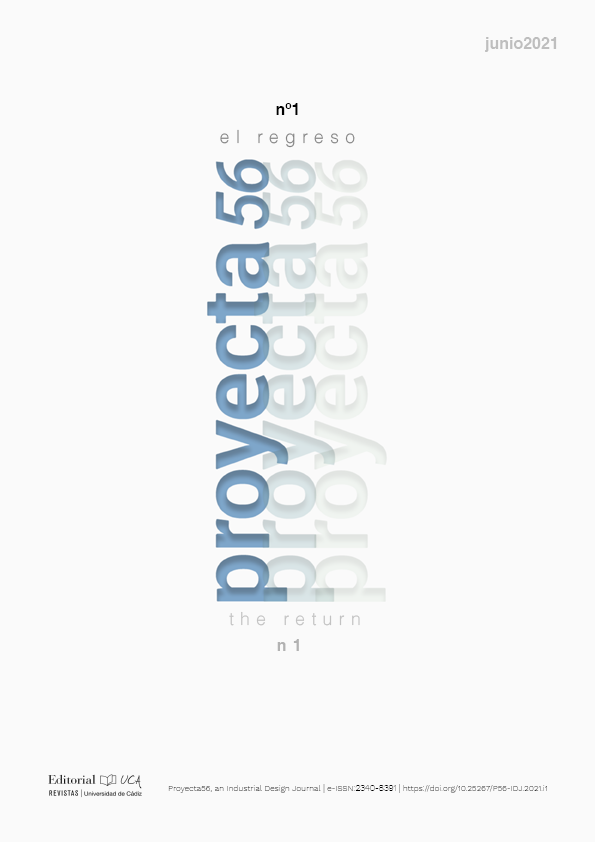The biomimicry designg espiral as inspiration for current design challenges and innovative sustainable solutions
Abstract
This paper presents an experience carried out in the field of product design aimed at knowing more in depth what biomimicry is, discovering the possibilities it offers when designing more sustainable products and introducing this inspiration in nature within the usual design thinking and process, thus putting two disciplines such as biology and design to work together.
This experience is designed through several collaborative workshops between future product designers and biology consultants belonging to the Biomimicry Granada association. This interdisciplinary collaboration does not seek mastery of many fields, but rather the opening to new disciplines that can offer different, more sustainable and innovative tools to define and solve design challenges. Knowledge and work with the biomimetic design spiral methodology is promoted through a guided application by experts. The actions carried out during the three months of the collaboration will be described in detail, as well as the results obtained in terms of learning and sustainable innovation.
Keywords
Downloads
How to Cite
License
This Journal is under a Creative Commons License Attribution-NonCommercial-NoDerivs 4.0 International.
References
Ask Nature. Recuperado de: <https://asknature.org/> [Consulta: 19/03/2021]
BAUMEISTER, D., TOCKE, R., DWYER, J., RITTER, S. y BENYUS, J. (2013). Biomimicry Resource Handbook: A Seed Bank of Knowledge and Best Practices. Missoula: Biomimicry 3.8.
BENYUS, J. (1997). Biomímesis. Innovaciones inspiradas por la naturaleza. Barcelona: Tusquets.
Biomimicry Institute. Recuperado de: <https://biomimicry.org/> [Consulta: 19/03/2021]
BIOMIMICRY INSTITUTE (2017). Ask Nature. The biomimicry taxonomy. Recuperado de: <https://toolbox.biomimicry.org/wp-content/uploads/2017/03/Taxonomy_Explainer_2017diagram.pdf> [Consulta: 19/03/2021]
BIOMIMICRY INSTITUTE. Biomimicry toolbox. Recuperado de: <https://toolbox.biomimicry.org/> [Consulta: 19/03/2021]
BIOMIMICRY 3.8. (2015). Perspectivas de diseño. Recuperado de: <https://biomimicry.net/> [Consulta: 19/03/2021]
DE PAUW, I., KANDACHAR, P., KARANA, E., PECK, D., & WEVER, R. (2010). "Nature inspired design: Strategies towards sustainability" en ERSCP-EMSU Conference on Knowledge Collaboration & Learning for Sustainable Innovation, p. 1–21.
LÓPEZ-FORNIÉS, I. y BERGES-MURO, L. (2014). "Aproximación al diseño biomimético. Aprendizaje y aplicación" en Dyna, 81 (188), p. 181-190. Recuperado de <https://www.redalyc.org/articulo.oa?id=49632758024> [Consulta: 19/03/2021]
Rediseñando el mañana, Dir. Pedro Aguilera. Belino Production. 2021. Recuperado de <https://www.lafabrica.com/madriddesignfestival/2021/02/09/redisenando-el-manana/> [Consulta: 19/03/2021]
ROSSIN, K.J. (2010). "Biomimicry: Nature´s design process versus the designer's process" en WIT Transaction on Ecology and Environment, 138, p. 559-570. Recuperado de <http://dx.doi.org/10.2495/DN100501> [Consulta: 19/03/2021]
SANTULLI, C. y LANGELLA, C. (2011). "Introducing students to bio-inspiration and biomimetic design: A workshop experience" en International Journal of Technology and Design Education, 21 (4), p. 471-485. Recuperado de <http://dx.doi.org/10.1007/s10798-010-9132-6> [Consulta: 19/03/2021]








